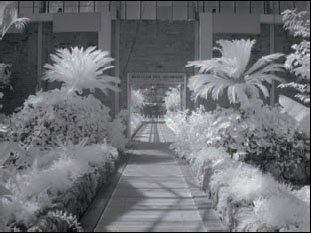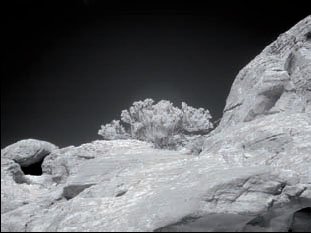articles/Infrared/patrickriceinfrared-page4
Patrick Rice - Infrared - part 4 of 1 2 3 4
Published 01/04/2006

Eyes Eyes can be very interesting in infrared. Some eyes photograph very well with infrared while others can be quite haunting. Whenever you are going to photograph a subject close-up in infrared with him or her looking back at the camera, take a test exposure with your digital infrared camera and use the camera's zoom function to bring up their eyes for closer inspection.
Besides zooming in on the eyes with the camera, I will also look at the image on the LCD screen with my 2x lupe to further enlarge the image. If the eyes look pleasing, go ahead and continue as you would for normal photography. However, if the eyes look strange, you may choose to have the client looking off to one side or down in the frame. I have found that deep blue eyes, like deep blue skies, tend to be very dark and even black.
Eyes without a hint of eye colour are somewhat disturbing and even ghostly - not usually the look I am trying to achieve.
It is a good rule of thumb to have your subject look slightly above the camera. This will maintain the appearance of the subject looking at the camera, while helping to keep definition in the eyes with infrared.

Hair Hair colour can be quite revealing with infrared imaging. My stepson, Travis Hill, and I were teaching a class on infrared wedding photography one day and discovered this first hand. Our model, a beautiful girl in her early twenties, had gorgeous blonde hair. We took photographs in colour, traditional panchromatic black and white as well as black and white infrared. After we had the images printed, we noticed that something seemed odd. When we compared the panchromatic black and white images with the black and white infrared images, the hair was completely different.
On the traditional black and white images, her blonde hair recorded a very light grey. However, with the black and white infrared images, her hair was very dark grey. After I pondered the difference for a while, I decided to test a theory. I called the model and asked her what her "real" hair colour was. The girl was stunned by the question but shyly admitted that she colours her hair to appear blonde. infrared imaging can see your true hair colour. Taking my theory a step further, I noticed that older individuals sometimes dye their hair back to the dark colour it was when they were younger to hide the natural greying of hair. In infrared imaging, hair that is in fact grey that is dyed darker will record a very light grey.
I only wish that I had discovered this revelation back when there was popular debate as to whether then President Ronald Regan dyed his hair to maintain its jet black, youthful appearance.
I am sure an infrared image that proved he dyed his hair could have brought a sizable paycheck from one of the tabloid newspapers!
Make-up Make-up can be used very effectively when photographing a subject in infrared. You can add dimension to the cheekbones and definition to the lips and eyes with the proper choice of colours in make-up. Be sure to avoid medium red colours if you have a red filter in front of your digital infrared camera. The filter may cancel out the make-up colour.
Tattoos can be a great subject of infrared photographers. Unlike suntans or sunburns, the ink that is used to colour the skin penetrates very deeply and records in stark contrast to the surrounding skin that is lighter than normal.
The only exception to this are some red tones in the tattoo that might be cancelled out by the red filter in front of your camera. Reds that fall into the same wavelength as your filter will appear white. When using a number 25 filter and photographing the United States' flag, the red and white stripes of old glory sometimes appear all white.
Please Note:
There is more than one page for this Article.
You are currently on page 4
- Patrick Rice - Infrared page 1
- Patrick Rice - Infrared page 2
- Patrick Rice - Infrared page 3
- Patrick Rice - Infrared page 4
1st Published 01/04/2006
last update 09/12/2022 14:57:26
More Infrared Articles
There are 0 days to get ready for The Society of Photographers Convention and Trade Show at The Novotel London West, Hammersmith ...
which starts on Wednesday 15th January 2025





